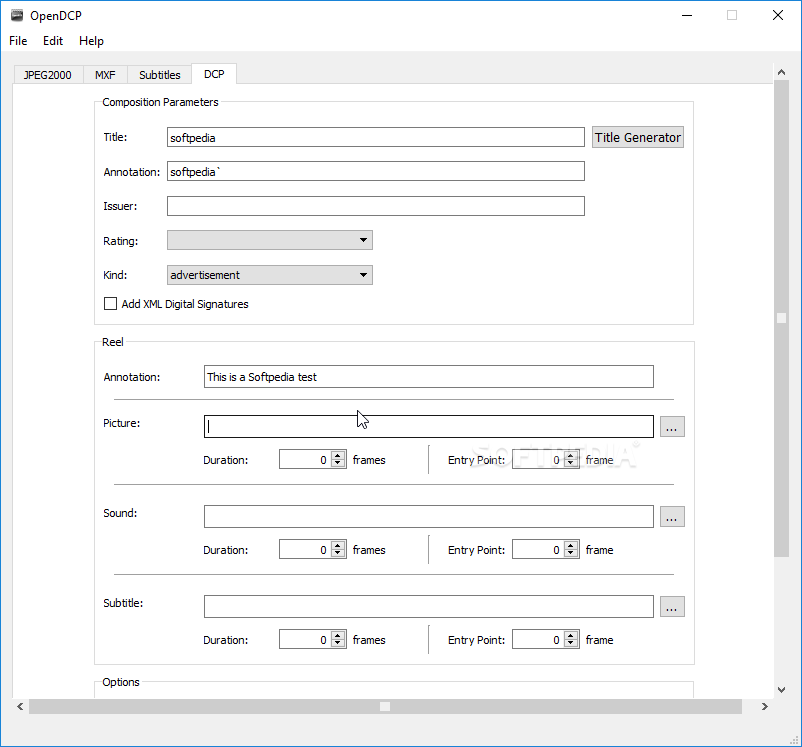In this post, we will provide step by step instructions for installing OpenCV 3.3.0 (C++ and Python) on MacOS and OSX.
Our website provides a free download of OpenDCP 0.30.0. The software lies within Multimedia Tools, more precisely Editors & Converters. The latest version of the program can be installed on PCs running Windows XP/Vista/7/8/10, both 32 and 64-bit. Our built-in antivirus checked this download and rated it. Free Download and information on OpenDCP - OpenDCP is an open source program to create digital cinema packages (DCP) for use in digital cinema. Main features: -JPEG2000 encoding from 8/12/16-bit TIFF images -Supports all. Download OpenDCP - An advanced and reliable application that enables you to generate Digital Cinema Packages which can then be used with digital cameras. We tried with Mac Extended Journaled first, and then went on a Linux system to transfer off, format to Ext3, then transferred back on. DCP server still couldn’t read it. Unfortunately, openDCP doesn’t have support presently. Download it from here. 21st September 2020. DCP-o-matic 2.14.38 was released. This release fixes two bugs: The -standard flag to dcpomatic2create should now work properly. Attempts to create films with empty names are now blocked so that they don't cause uncaught exception errors. Download it from here. 14th September 2020.
Step 1: Install XCode
Install XCode from App Store.
If XCode available on App Store is not compatible with your OS:

- Find XCode version compatible to your OS from this table https://en.wikipedia.org/w/index.php?title=Xcode#Version_comparison_table
- Go to this webpage https://developer.apple.com/download/more/
- Login if you have apple developer account else create your account and login.
- Search for xcode and download the version compatible to your OS.
- Install XCode.
- After installation open XCode, and accept xcode-build license when it asks.
Step 2: Install Homebrew
Launch a terminal from Launchpad. From this step onward, all commands will be run in the terminal.
Step 3: Install Python 2 and Python 3
Python version (2.6 or 2.7, 3.5 or 3.6) installed on your machine is required to determine path of Python’s site-packages. It will be used later.
NOTE : Recently Homebrew made some changes in Python formula. Earlier homebrew used to install python2 as /usr/local/bin/python. Now it follows these rules:
- Install python2 at /usr/local/bin/python2
- Install python3 at /usr/local/bin/python3
- python command will point to /usr/bin/python. This is the python distribution which comes with your OS and not installed by Homebrew.
We want to use Python installed by Homebrew because it makes installing/managing packages easier. To run python scripts you should run command python2 and python3 for Python 2 & 3 respectively. If you find this annoying and want to use command python to run python2, add following line to ~/.bash_profile.
This step is recommended not just for this course but in general to keep the python installation clean.
Step 4: Install Python libraries in a Virtual Environment
We will use Virtual Environment to install Python libraries. It is generally a good practice in order to separate your project environment and global environment.
Step 5: Install OpenCV
Step 5.1 : Compile & Install OpenCV
Note: Homebrew recently moved many popular formulae to homebrew-core.
Earlier you can install OpenCV 2 using formula name opencv and OpenCV 3 using formula name opencv3.
They have now renamed opencv3 to opencv and opencv to [email protected]
Various options such as –with-qt, –with-tbb etc are also removed in the updated formula and CUDA support is also dropped.
You can check these github issues 15853, 6126, 16640, 5996
to read more about it.
Homebrew has also made it compulsory to compile and install Python bindings for both Python 2 and Python 3. So if you don’t have Python 3 installed, Homebrew will install it while installing opencv.
Step 5.2 : Add OpenCV’s site-packages path to global site-packages
When brew is done compiling and installing OpenCV3, we will update path of site-packages directory which contains cv2.so file to Homebrew Python’s site-packages directory. Depending upon the Python version you have (2.6/2.7 or 3.5/3.6) these paths would be different.
Step 6: Make OpenCV3 Python symlink in our virtual environment
Path to OpenCV’s Python library will be different depending upon which Python version you have. Double check the exact path and filename on your machine. Use this command to find out the path on your machine.
Step 7: Test OpenCV3
Now you can exit from Python virtual environment.

Now whenever you are going to run Python scripts which use OpenCV you have to activate the virtual environment we created using workon command.
Subscribe & Download Code
Opendcp Free Download For Mac

Opendcp Mac Download
If you liked this article and would like to download code (C++ and Python) and example images used in all posts of this blog, please subscribe to our newsletter. You will also receive a free Computer Vision Resource Guide. In our newsletter, we share OpenCV tutorials and examples written in C++/Python, and Computer Vision and Machine Learning algorithms and news.
